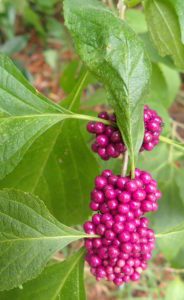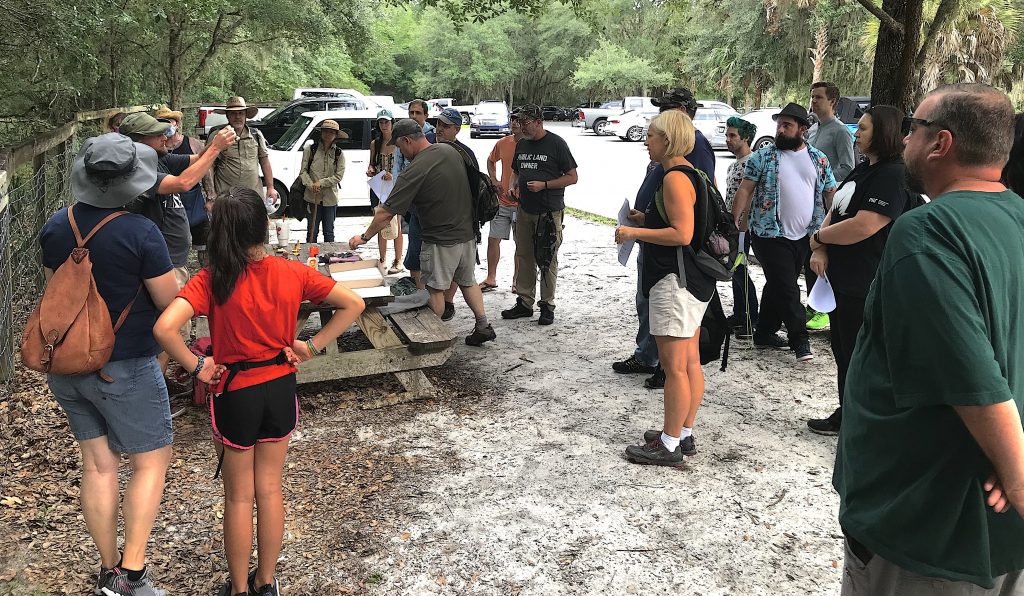
Some two dozen mushroom enthusiasts joined Joshua Buchanan and the Orlando Mushroom Group for a hunt Saturday. Fortunately several days of rain made finding mushrooms easy. Photo by Green Deane
Sugar maples are famous for their syrup but how many species of trees can you actually tap? In North America the answer is at least 22. “Sugaring” was a special time of year in New England. Warm days and near freezing nights in the spring started the sap flowing out of the roots back towards the top of the trees. A tap and a bucket produced pails of mildly sweet sap. Hours of boiling reduced that to maple syrup. Have you ever heard of Maple Walnut Ice Cream. It was common in sugaring country.
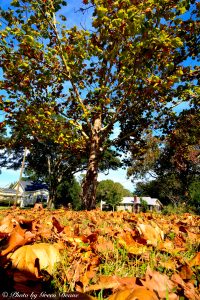
Sycamores drop a lot of leaves.
The largest group of trees you can tap are maples ( Sugar, Black, Red, Silver, Norway, Boxelder, Bigleaf, Canyon, Rocky Mountain, and Gorosoe.) The birches can also be tapped (Paper, Yellow, Black, River, Gray, and European White Birch.) If I remember correctly no native group of Europeans ever tapped them for food until they learned of the practice in North America. Trees in the walnut group can also be tapped: Butternut (my mother’s favorite) Black Walnut, Heartnut, and English Walnut.
There are two outliers which grow locally. One is Hophornbeam or as I called it growing up, Ironwood. It also has edible seeds. The other tappable species is a very common native and ornamental: The Sycamore. It takes about four to five times more Sycamore sap to get a gallon of syrup than from a Maple. The biggest surprise is that Sycamore Syrup tastes like butterscotch. Processing a natural plant does not always have the outcome you intend. Seagrapes, for example, have a unique taste. Make them into jelly, however, and their originality disappears and they taste like apple jelly. And while birch syrup is a unique and commercial product. It can taste quite similar to molasses. You can read about Sycamores here, Ironwood here.
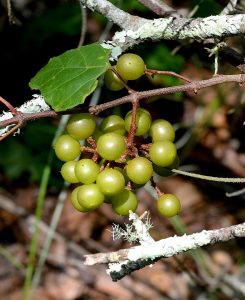
VItis munsoniana getting close to ripening. Photo by Green Deane
Will wild grapes be early this year? The general calendar date for them is September first. In Maine in the past school always started the Tuesday after Labor Day. A couple of weeks later I’d be late for school and home because of grapes and apples. I walked two miles each way and that took me past hedgerows of Concord Grapes. A couple of weeks apples in the nearby orchard got y attention. Before modern slang “scrumping” meant stealing local fruit usually by kids. And that I did though most of these vines and trees were around old farmsteads and not tended. Locally grapes have shown up in August even late July. Here it is mid-June and this past week I saw several getting ready-to-ripen clusters on local muscadines. (I was hunting mushrooms at the time but that’s how one often gets a lead on food to come.) These are in the single-tendril group. I suspect the forked-tendril ones will wait until September to ripen. You can watch my video on grapes here and read about them here.

Classes are held rain or shine.
Foraging classes this weekend are on the west coast, New Port Richey and Port Charlotte.
Saturday June 20th, John Chestnut County Park: 2200 East Lake Road, Palm Harbor, FL 34685. Meet at the trail head of the Peggy Park Nature Walk, pavilion 1 parking lot. 9 a.m. until noon.
Sunday, June 21st, Bayshore Live Oak Park, Bayshore Drive. Port Charlotte. 9 a.m to noon. Meet at the parking lot at Bayshore Drive and Ganyard Street 9 a.m. to noon.
Saturday, June 27th, George LeStrange Preserve, 4911 Ralls Road, Fort Pierce, FL, 34981. 9 a.m. to noon. Third time is a charm. This class has had to be rescheduled twice because of weather. This is also the only location without any official bathrooms.
Sunday, June 28th, Haulover Canal, Merritt Island National Refuge, north of the Kennedy Space Center, 9 a.m. to noon. This is contingent on the park being open. I will get a definite answer this coming week.
For more information, to pre-pay for a class or to sign up go here.
Locally the American Beautyberries are blossoming and soon they will have magenta berries. I’m going to try to make them into some wine this year. That said Beautyberries are near the bottom of the list on flavor, insipid more than offensive. But they make a great jelly… and perhaps a blush wine. They are not good pie material and in muffins they turn green. The shrub itself has been known for its ability to repel insects. “Diane” wrote a letter from in praise of the Beautyberry and insect control
“We have been plagued by mosquitoes and those biting deer and horse flies while riding our horses in the woods. Last week we had to dismount and brush about 30 of them from underneath our horses bellies just in order to keep them from going crazy and bolting off. Even though we don’t like using the traditional store-bought horse fly sprays, we did try several over the last couple of years and none of them really work all that well. After reading [your article] we experimented this weekend with the beautyberry. We cut small branches we tucked into their tack. We also rubbed some fresh leaves all over ourselves and the horses. We could not believe the results! We had a two-hour ride each day this past weekend and we’re not troubled by any biting insects. There was an occasional fly that attempted to make a problem but was easily shooed away. We are so lucky to have tons of this bush growing all over our pastures. It is also along every trail that we ride on so it is easily acquired along the ride as well. Thank you!”
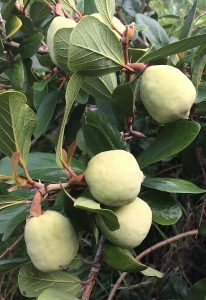
Is it time to take the Creeping Fig out of the edible realm? Photo by Green Deane
What is it? The answer is barely edible. Many years ago while sipping a beer at an outside bar in Ybor City I saw a prolific vine on a brick wall with what looked like a large green fig. I was reasonably sure it wasn’t a product of the beer so some research was in order. It was a Creepin Fig. The main problem with the species — besides barely making it into the edible realm — is growth pattern. The leaves and vines of the fig when young are very small then at some point the plant transforms itself into a large vine with leaves having little resemblance to what it used to be. Then it produces green fig-like fruit. The fruit basically is not edible. But the expressed juice jelled in water is. That’s a bit strange. To read about it, go here.
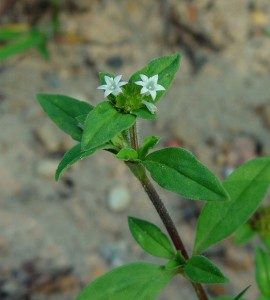
Richardia is generally not edible.
If a plant does not cause acute illness then judging when it might make you ill is difficult to say. It might take months of consumption (or perhaps with something like canned fiddlehead ferns, years.) One of those possible plants is Florida Purley, aka Richardia scabra. I do know of a couple people who ate a leaf and had no problem. They mistook it for chickweed. I know of someone who ate several leaves at once and had gastrointestinal distress. And the roots are reportedly an emetic. More telling is that we have little information about how if at all it was used by Native Americans. That often is a clue it’s a plant to avoid, at least from a food point of view. If a plant is not in the ethnobotanical literature either the natives didn’t use it, we didn’t ask, or they didn’t tell us. It is best to stick we plants that we know for certain were used for food.

Green Deane videos are now available on a USB.
Changing foraging videos: My nine-DVD set of 135 videos has been selling for seven years. They are the same videos I have on You Tube. Some people like to have a separate copy. The DVD format, however, is becoming outdated. Those 135 videos plus 15 more are now available on a 16-gig USB drive. While the videos can be run from the DVDs the videos on the USB have to be copied to your computer to play. They are MP4 files. The150-video USB is $99 and the 135-video DVD set is now $99. The DVDs will be sold until they run out then will be exclusively replaced by the USB. This is a change I’ve been trying to make for several years. So if you have been wanting the 135-video DVD set order it now as the price is reduced and the supply limited. Or you can order the USB. My headache is getting my WordPress Order page changed to reflect these changes. We’ve been working on it for over three weeks. However, if you want to order now either the USB or the DVD set make a $99 “donation” using the link at the bottom of this page or here. That order form provides me with your address, the amount — $99 — tells me it is not a donation and in the note say if you want the DVD set or the USB.

Green Deane Forum
Want to identify a plant? Perhaps you’re looking for a foraging reference? You might have a UFO, an Unidentified Flowering Object, you want identified. On the Green Deane Forum we — including Green Deane and others from around the world — chat about foraging all year. And it’s not just about warm-weather plants or just North American flora. Many nations share common weeds so there’s a lot to talk. There’s also more than weeds. The reference section has information for foraging around the world. There are also articles on food preservation, and forgotten skills from making bows to fermenting food.
This is weekly newsletter 410, If you want to subscribe to this free newsletter you can find the sign-up form in the menu at the top of the page.
To donate to the Green Deane Newsletter click here.

